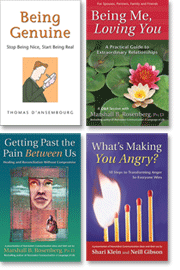 |
||||
 |
Filling Your Emotional Tank By Jessica Dancingheart (Boulder County Kids, Spring 2008) |
|
|
You’ve had a long day at work. You pick your children up from day care or school and they’re cranky and tired. You’re ready for some down time and the thought of having to do one more thing for someone else feels overwhelming. Your kids begin to ask things of you and don’t listen to what you have to say or what you want. Your partner is preoccupied with a project. Keep reading this article >> |
 |
Four Surefire Ways to Ruin a Relationship By Rachelle Lamb |
|
|
For years I have been speaking and writing about how our communication can greatly enhance our relationships and life experiences. For something completely different, I thought I’d offer readers some surefire ways to effectively ruin relationships. Keep reading this article >> |
|
|
|||
|
|
|||
|
|
||
|
Free Weekly Tips Series: •••Living Compassion Tips
PDF Downloads: |
|
|
|||
|
"The first step in healing is to focus on what's alive now, not what happened in the past." Marshall Rosenberg, Ph.D.
|
|||
|
|
That’s right . . . ruin relationships! We could also call it the Thomas Edison approach . . . a few tips on how not to go about “lighting” up the faces of those you love. For those who might be curious, here are some all time favorites.
1. Blame and criticize.
This probably tops them all! Nothing compares to a good dose of blame and criticism.Be sure to include denigrating labels as well. Let me provide you with a few winning examples . . . call your spouse “uncaring and insensitive”, your teen “ungrateful”, your boss “incompetent”, your sister “manipulative”, the government “irresponsible”.
There are so many I could fill a volume. Believe me – these work!!! Faster than your neo-cortex will have the chance to reflect on the truly amazing efficiency of your reptilian brain, you will have made certain that the person you are speaking to erects a virtually impregnable barrier of self-defense.
Think about it . . . nine times out of ten, hasn't blame and criticism aimed in your direction had the same effect? And the beauty of this is . . . the more a person is exposed to this treatment, the faster they become at putting up walls. Some people even decide to leave the walls there permanently.
Another benefit to this technique is that the speaker also gets to feel lousy even though he or she is talking about someone else. And by the way, it’s also just as effective used directly on oneself!
2. Deny responsibility for your actions.
You’ll get fast results with this one!! It’s related to blame in that you get to point your finger at someone else or at an entity such as an organization.But here’s where the magic happens . . . you then get to stand back and make others responsible for all your woes. So much fun! If you like to think “poor me” and “if only”, this one is unbeatable!
3. Order people around.
Ooooh honey I love it when you tell me what to do! Any joy the other person might have had in doing what you want is instantly lost when they’re told to do it. Even if the person ends up doing what you want, it will be out of submission and you can be pretty sure you won’t be getting the best the other person has to offer. Hello resentment! If on the other hand, the person happens to have a rebellious streak, you have another kind of mess to deal with. Either way, it’s a mess.Over time, this method erodes the very foundation of the relationship. Don’t take my words for it though. Try it for yourself. Don’t wait another minute!
4. Threaten people.
Another winner!! When others think they may be punished or have something taken away as a result of not doing things your way, this sets the platform for lying, cheating, conniving, manipulation, crime and other wonderful things. This is lose/lose at its very best!There are plenty more “relationship busters” I could share but these definitely top the list. And what’s great is that these proven winning techniques can be applied in many different scenarios with consistent results.
If, however, after using these methods for a while, you discover your energy is slowly being drained and you start hankering for a change, then I invite you to discover some effective alternatives.
Recent polls indicate that the number of people being drawn to relate differently is clearly on the rise. In fact it appears that the Ruin Your Relationships Formula is fast becoming antiquated and losing popularity. Conversely, there is a burgeoning interest in exploring win-win formulas.
This is where Nonviolent Communication (NVC) comes in handy. NVC is a powerful process that uses communication to serve a very different purpose. It places a premium on facilitating trust, openness and optimism and inspires people to work together in genuine partnership – in both home and workplace settings.
Should you happen to be one of the individuals who is tiring of the ruinous habits mentioned above, and would appreciate a refreshing change, come join the growing numbers of people who are using this process to positively transform their communication and their relationships.
Learning NVC is fun, informative, and engaging. You’ll end up with an exciting tool-kit and once you gain some proficiency, you’ll be sure to draw some surprised looks from the people in your life as well as some smiles!!!
Rachelle Lamb is president of Mindful Communication and a certified trainer of Nonviolent Communication – a NEEDS based model that helps people communicate in ways that inspire goodwill and cooperation. Her website is www.RachelleLamb.com
Keep learning these vital communication skills with these books and training resources:
- Living Compassion Weekly Tip Series - Complimentary
- NVC Extraordinary Relationships Book Package - Save 50% through October 31, 2008

"When others think they
may be punished or have something taken away
as a result of not doing
things your way, this sets
the platform for lying,
cheating, conniving, manipulation, crime and
other wonderful things."
- Rachelle Lamb

